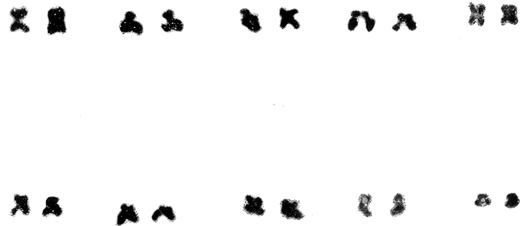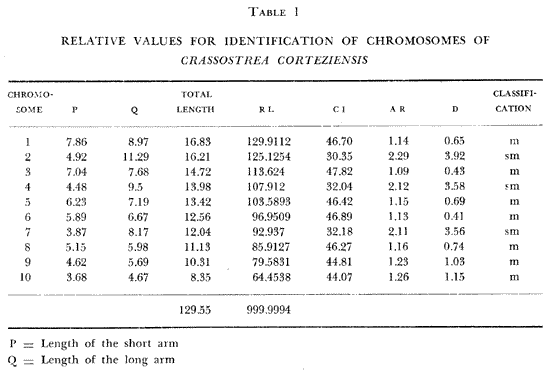|
THE KARYOTYPE OF CRASSOSTREA CORTEZIENSIS HERTLEIN
(MOLLUSCA: OSTREIDAE)
Trabajo presentado en el VI Congreso Nacional de
Oceanografía, Ensenada B. California México, 10 al 13 de abril,
1978. Recibido el 9 de noviembre de 1977 y aceptado, para su publicación
el 28 de febrero de 1978.
FAUSTINO RODRÍGUEZ-ROMERO
MANUEL URIBE-ALCOCER
ALFREDO LAGUARDA-FIGUERAS
Universidad Nacional Autónoma de
México, Centro de Ciencias del Mar y Limnología.
Contribución 89 del Centro de Ciencias del Mar y Limnología,
UNAM.
The Karyotype of the species Crassostrea
corteziensis shows a diploid number of 20 (2n) The Chromosomes occur
in pairs and are very similar in size, shape and centromeric position. They are
classified as metacentrics with exception of the pairs 2, 4 and 7 that are
submetacentrics. Secondary constrictions as well as satellites were not
identified. In meiosis, at cigotenic and diakinetic stages, 10 chromosomic
bivalent complexes were found which corroborate the diploid number in this
population.
The results of this study, with regard to the diploid
number as well as the general morphology of the chromosomes agree with previous
works on the Crassostrea genus.
El cariotipo de la especie Crassostrea
corteziensis, presenta un número diploide de 20 (2n) . Los
cromosomas se presentan en pares y son muy similares en cuanto a su
tamaño, forma y posición del centrómero; fueron
clasificados como metacéntricos con excepción de los pares 2, 4 y
7, que se presentan como submetacéntricos. No fueron identificadas
regiones heteropicnóticas, constricciones secundarias y satélites
en los cromosomas mitóticos. En cigóteno y diacinesis de la
primera profase de la meiosis, se encontraron 10 complejos cromosómicos
bivalentes que corroboran el número diploide en esta especie.
Crassostrea corteziensis, ha sido objeto de confusiones
respecto a su posición taxonómica a nivel de género; sin
embargo, los resultados de este estudio, tanto para el número diploide,
como, para la morfología de los cromosomas son congruentes con los
obtenidos en otros trabajos similares en organismos pertenecientes al
género Crassostrea.
Morphological features on the oyster shells of the genera Ostrea and Crassostrea, have been used to illustrate somo taxonomic problems; nevertheless, an extensive shell variation exists in many oyster populations as a consequence of specific environmental factors (Menzel, 1968). Thus this has provoked confusion when considering ecomorphic populations as different species (Hertlein, 1951; Menzel, 1968; Bonilla-Ruiz, 1969 y Stuardo y Martinez, 1975; Castillo, 1977). In searching for possible solutions to this problem new biological criteria have been recently utilized to solve some taxonomic problems. One of this criteria is citotaxonomy which studies cytogenetic features between related species and populations. A cytogenetic analysis on the chromosomes of Crassostrea corteziensis is reported here with specimens obtained from Puerto San Blas, Nayarit México. The purpose of the analysis was to compare the karyotype of C. corteziensis with the results of similar studies performed on the family Ostreidae. MATERIAL AND METHODSSpecimens from Estero de Pozo, San Blas, Nayarit, México, were processed to obtain chromosomes by air drying technique. A. 0.01% colchicine solution was used to stop mitotic metaphases (2 drops in 5 m1 of 2.2% sodium citrate solution) , 1 hour before centrifugation. A 1% sodium hipotonic solution was used. The cells were fixed with Carnoy and slides were stained with giemsa and mounted in balsam. The chromosomes of the karyotype were statistically analyzed and classified as Levan et al. (1964) and Al-Aish (1969). RESULTSMitotic chromosome analysis All the mitotic figures analyzed here showed 20 biarmed chromosomes (Fig. 1) . The chromosomic size and shape of the elements of the karyotype show slight differences with the exception of the first and last pairs. The chromosomes were ordained in pairs and classified as as heteropicnotic zones, secondary constrictions and satellites were not identified. Meiotic chromosomes At cigotenic and diakinetic stages, abundant meiotic chromosomes were common in eggs of Crassostrea corteziensis. The egg cells at this metacentrics with the exception of the pairs 2, 4 and 7 that are submetecentrics (Table 1) . The arm number is 40. The centromeric region of each chromosome was easy to identify. Other features of the chromosomic morphology such stage sho-wed ten bivalent chromosomic complexes. At cigotene, the bivalents were well defined; diakinetic chromosomes showed kiasmas with some of them at terminalization stage. No meiotic figures at metaphase II were observed.  Fig. 1. The Karyotype of Crassastrea corteziensis.  TABLE 1 RELATIVE VALUES FOR IDENTIFICATION OF CHROMOSOMES OF CRASSOSTREA CORTEZIENSIS DISCUSSIONThe genus Crassostrea is common along the mexican Pacific coast. At least 10 species have been reported from that area. The species studied was identified as Ostrea chilensis by several authors, Hertlein (1951), found enough shell morphologic differences in oysters from Sonora, Mexico, to propose a as a new species Ostrea corteziensis. Stuardo and Martinez (1975) and Castillo (1977), summarized information about the need to consider this organism as belonging to the Crassostrea genus based on anatomical features. Moreover, great similarity between Crassostrea corteziensis and C. virginica, was found by this author. Preliminar studies in other species of Crassostrea have been reported in which some karyotypic features such as diploid number and gross chromosomic morphology have been determined. It will be interesting to compare the results of this work with other studies already reported in the literature for species discrimination. The diploid number (2n) = 20 in these oysters is similar to others of the same genus already studied, for example: C. angulata, C. comercialis, C. gigas, C. iradalei, C. rizhopora y C. virginica (Menzel, 1968; Longwell and Stiles, 1967 and 1970). According to White (1951), this diploid number is low and the high percentage of metacentric chromosomes in this karyotype is in accordance with the idea that this karyotypc is primitive. White (1951), concludes that a karyotype with a low diploid number and high percentage of metacentric chromosomes shows slight variation after several generations. This is the case of the karyotype of C. corteziensis. Longwell and Stiles. (1967), studied the chromosomes. of Crassostrea-virginica. They reported some interesting peculiarities of the karyotype as a secondary constriction and a satellite in the first chromosome pair. In Crassostrea corteziensís neither secondary constrictions nor satellites were found. This could be a fundamental difference among the karyotype of both species although technical procedures in karyotying this species could have contributed to this discrepancy. However, the same technical procedure has been used to analyze the karyotype of C. virginica found along the mexican coast (Tabasco) and the chromosome features observed are in agreement with those observed by Longwell and Stiles. Sex chromosomes have been reported in studies of the karyotype of some Gasteropods. In the Ostreidae there is no evidence of this kind of chromosomes (Longwell, 1967. Lonwell et al., 1970), which permits us to analize the female karyotype as valid for all the oyster populations. No evidence of sexual chromosomes exists in Crassostrea corteziensís. The results from this study after meiotic chromosome analysis are in accordance with the diploid number of mitosis. To the 20 mitotic chromosomes correspond a number of 10 bivalent chromosomic complexes at first meiotic prophase. Future researches on karyotypic features comparison with species of different genus such as Crassostrea and Ostrea, will be usefull to understand the influence of ecological changes on karyotype readjustment and chromosomic evolution of these genera. CONCLUSIONSThe karyotype of Crassostrea corteziensis shows a diploid number of 20. The chromosomes are in pairs and similar in size, shape and centromere position. Only metacentric and submetacentric chromosomes were found without secondary constrictions or satellites. The prophase meiotic chromosomes which form 10 bivalent complexes, are in agreement with the diploid number found in mitosis. ACKNOWLEDGEMENTSThe Autors wish to thank Antonio Garcia Cubas, for the critical review of the manuscript and Enrique Mandelli for revision of the English text. LITERATURAAL-AISH, M. S. Human chromosome morphology. 1. Studies on normal chromosome characterization, classification and karyotyping. Can. J. Genet. Cytol. 1969 370-381 11 BONILLA-RUIZ, J. Notas sobre aspectos biológicos de las ostras. Lagena 1969 48-68 23 y 24 CASTILLO, Z. G. Contribución al estudio taxonómico de algunas especies mexicanas de la familia Ostreidae. Tesis profesional Fac. Ciencias. Univ. Nal. Autón. México 1977 108 p. STUARDO, J. y A. MARTÍNEZ Relaciones entre algunos factores ecológicos y la Biología de poblaciones de Crassostrea corteziensis-Hertlein 1951, de San Blas, Nayarit, México An. Centro de Cienc. del Mar y Limnol. Univ. Nal. Autón. México 1975 89-129 1 2 HERTLEIN, L. G. Descriptions of two new species of marine pelecypods from west México Bull Cal. Acad. Sci. 1951 68-75 2 50 LEVAN, A., K. FREDGA and A. A. SANDBERG Nomenclature for centromeric position on chromosomes. Hereditas 1964 20-220 52 LONGWELL, A. C., S. S. STILES and D. G. SMITH Chromosome complement of the american oyster Crassostrea virginica, as seen in meiotic and cleaving eggs. Can. J. Genet. Cytol. 1967 845-856 9 LONGWELL, A. C. y S. S. Stiles El sistema genético y potencial reproductor de la ostra americana. Endeavour 1970 94-99 107 29 MENZEL, R. W. Cytotaxonomy of clams (Mercenaria) and oysters (Crassostrea). Proc. Symp. Moll. 75-87 part 1 WHITE, M. J. D. Citología Animal y Evolución Espasa-Calpe Argentina, S. A. México 1951 511 p.
|

